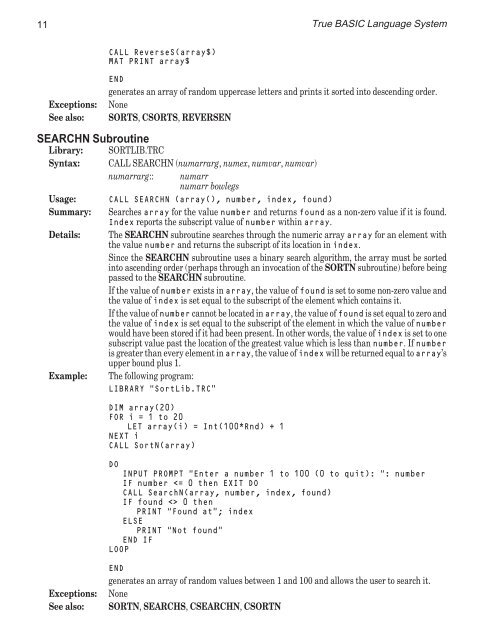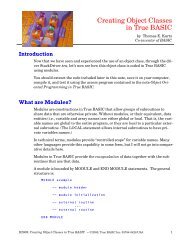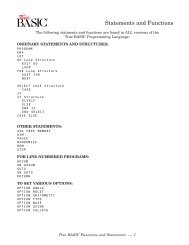Download the documentation - True BASIC
Download the documentation - True BASIC
Download the documentation - True BASIC
You also want an ePaper? Increase the reach of your titles
YUMPU automatically turns print PDFs into web optimized ePapers that Google loves.
11<br />
<strong>True</strong> <strong>BASIC</strong> Language System<br />
CALL ReverseS(array$)<br />
MAT PRINT array$<br />
Exceptions:<br />
See also:<br />
END<br />
generates an array of random uppercase letters and prints it sorted into descending order.<br />
None<br />
SORTS, CSORTS, REVERSEN<br />
SEARCHN Subroutine<br />
Library:<br />
Syntax:<br />
Usage:<br />
Summary:<br />
Details:<br />
Example:<br />
SORTLIB.TRC<br />
CALL SEARCHN (numarrarg, numex, numvar, numvar)<br />
numarrarg:: numarr<br />
numarr bowlegs<br />
CALL SEARCHN (array(), number, index, found)<br />
Searches array for <strong>the</strong> value number and returns found as a non-zero value if it is found.<br />
Index reports <strong>the</strong> subscript value of number within array.<br />
The SEARCHN subroutine searches through <strong>the</strong> numeric array array for an element with<br />
<strong>the</strong> value number and returns <strong>the</strong> subscript of its location in index.<br />
Since <strong>the</strong> SEARCHN subroutine uses a binary search algorithm, <strong>the</strong> array must be sorted<br />
into ascending order (perhaps through an invocation of <strong>the</strong> SORTN subroutine) before being<br />
passed to <strong>the</strong> SEARCHN subroutine.<br />
If <strong>the</strong> value of number exists in array, <strong>the</strong> value of found is set to some non-zero value and<br />
<strong>the</strong> value of index is set equal to <strong>the</strong> subscript of <strong>the</strong> element which contains it.<br />
If <strong>the</strong> value of number cannot be located in array, <strong>the</strong> value of found is set equal to zero and<br />
<strong>the</strong> value of index is set equal to <strong>the</strong> subscript of <strong>the</strong> element in which <strong>the</strong> value of number<br />
would have been stored if it had been present. In o<strong>the</strong>r words, <strong>the</strong> value of index is set to one<br />
subscript value past <strong>the</strong> location of <strong>the</strong> greatest value which is less than number. If number<br />
is greater than every element in array, <strong>the</strong> value of index will be returned equal to array’s<br />
upper bound plus 1.<br />
The following program:<br />
LIBRARY “SortLib.TRC”<br />
DIM array(20)<br />
FOR i = 1 to 20<br />
LET array(i) = Int(100*Rnd) + 1<br />
NEXT i<br />
CALL SortN(array)<br />
DO<br />
INPUT PROMPT “Enter a number 1 to 100 (0 to quit): “: number<br />
IF number









